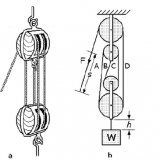Rotary Linear Linkages – SCOTH-YOKE Mechanism 51024
The Scotch yoke is a mechanism for converting the linear motion of a slider into rotational motion or vice-versa. The piston or other reciprocating part is directly coupled to a sliding yoke with a slot that engages a pin on the rotating part. The shape of the motion of the piston is a pure sine wave over time given a constant rotational speed.
Scotch-yoke mechanism, pictured in Fig. functions in a manner similar to that of the simple crank mechanism except that its linear output motion is sinusoidal. As wheel A, the driver, rotates, the pin or roller bearing at its periphery exerts torque within the closed yoke B; this causes the attached sliding bar to reciprocate, tracing a sinusoidal waveform. Part a shows the sliding bar when the roller is at 270°, and part b shows the sliding bar when the roller is at 0°.
Applications
This mechanism is most commonly used in control valve actuators in high pressure oil and gas pipelines. Although not a common metalworking machine nowadays, crude shapers can use a Scotch yoke. Almost all those use a Whitworth linkage, which gives a slow speed forward cutting stroke and a faster return. It has been used in various internal combustion engines, such as the Bourke engine, SyTech engine, and many hot air engines and steam engines.
Link
http://youtu.be/_K4PSV4MO70





